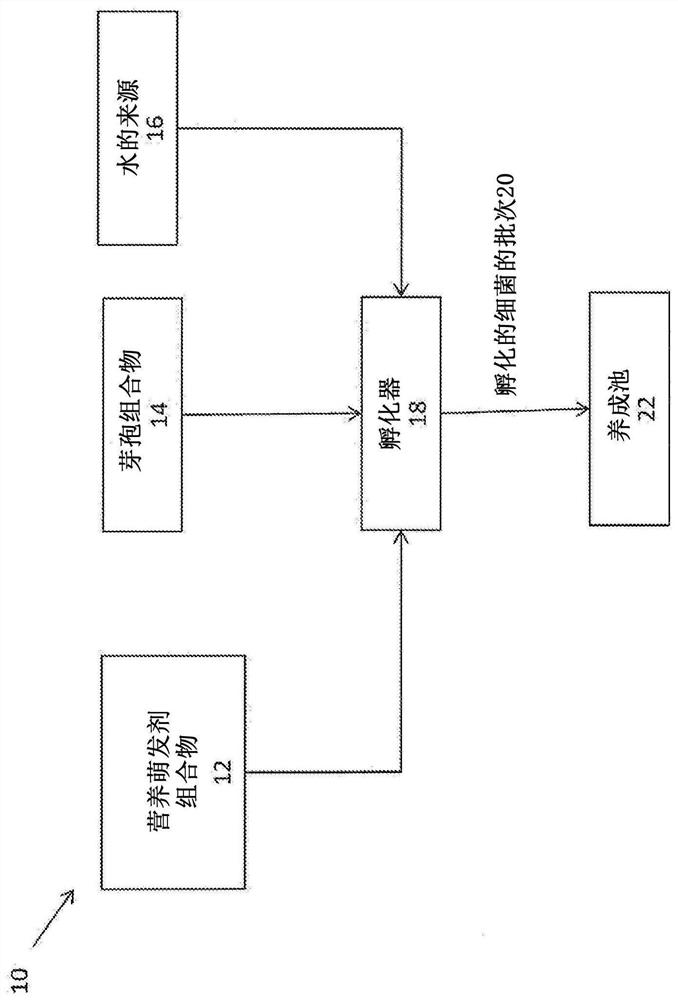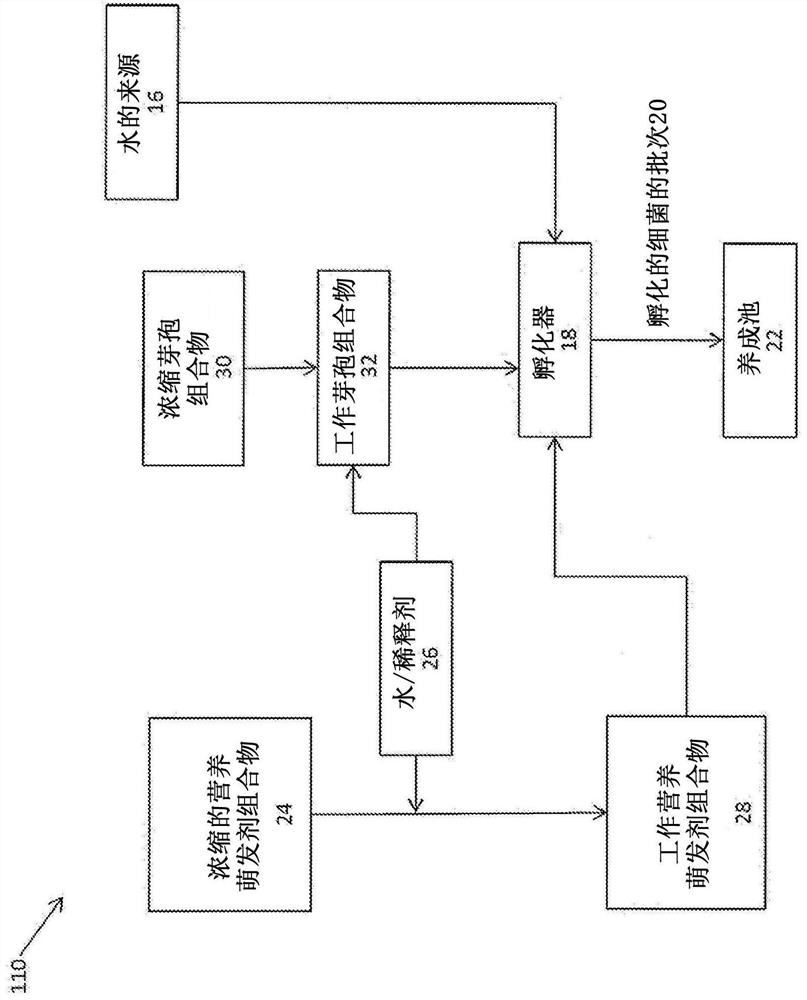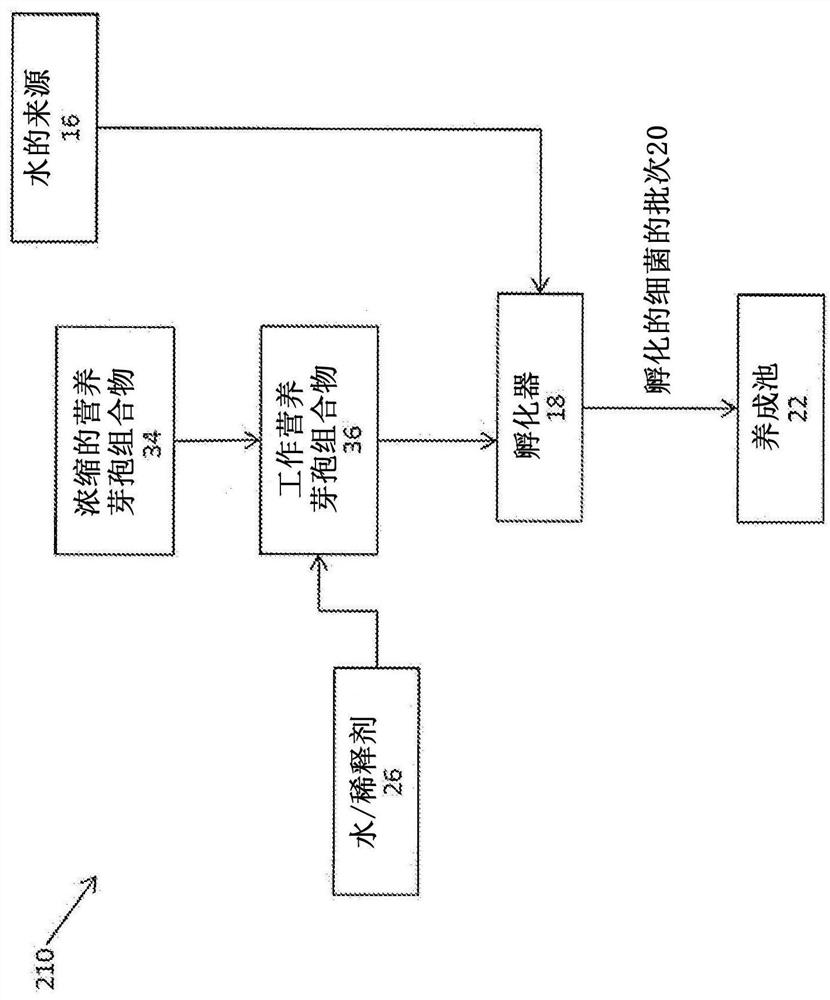Method for improving quality of aquaculture pond water using a nutrient germinant composition and spore incubation method
An aquaculture, composition technology, applied in chemical instruments and methods, biological water/sewage treatment, polluted waterway/lake/pond/river treatment, etc., can solve problems such as deterioration, low nitrification activity, increased disease pressure, etc. , to achieve the effect of improving yield, promoting nitrification activity and ammonia reduction, and reducing disease pressure
- Summary
- Abstract
- Description
- Claims
- Application Information
AI Technical Summary
Problems solved by technology
Method used
Image
Examples
Embodiment 1
[0113] Example 1 - In order to germinate the spores, FreeFlow LF-88 probiotics (commercially available spore liquid preparation from NCH Company) were added to a final concentration of about 1×10 9 CFU / mL was added to 1 mL of tap water, where CFU stands for colony forming unit. A preferred embodiment according to the invention comprising L-alanine (89 g / L), sodium dihydrogen phosphate (20 g / L), disodium hydrogen phosphate (60 g / L) and Linguard CP (total 1.6 g / L) The nutrient germinant concentrate composition was added to the water and bacteria mixture to provide a 4% final concentration of the nutrient germinant composition based on the total weight of the mixture. For comparison, a negative control reaction was prepared with the same amount of free-flow LF-88 probiotic bacteria and water, but without the addition of the nutrient germination concentrate composition. The two mixtures (germinant without nutrient germinant composition and negative control) were blended and incub...
Embodiment 2
[0118] Example 2 - Another set of incubation tests was performed using the same test mixture / incubation method (incubation using the same nutrient germination composition and heat, "treated spores, 42°C") and repeating what was done in Example 1 above Control mixture / incubation method as described (no nutrient germination composition and no heat, untreated spores, 23° C.), but a different test was performed to compare the performance of the test mixture according to a preferred embodiment of the invention compared to the control mixture. effect. In addition, two other mixtures were tested - one of which used the vegetative germination composition of Example 1 but without heating ("Treated spores, 23°C"), and the other without the vegetative germination agent but with spores heated ("Untreated spores, 42°C"). Briefly, spores were incubated at 42°C or 23°C for 1 hour with or without treatment with the preferred vegetative germination composition. After incubation, spores from ...
Embodiment 3
[0123] Example 3 - Another set of incubation tests was performed using similar test and control mixtures and incubation methods as described in Example 1 above. In short, the LF-88 with about 10 8 A final concentration of CFU / mL was added to 10 mL of distilled water. Samples were incubated at various temperatures to demonstrate the efficacy of the test method according to the preferred embodiment of the present invention compared to a control mixture. Prepare the reaction with the vegetative germination composition described in Example 1 ( Figure 9 "Treated spores" in ) and incubated at 23°C (ambient temperature, no heating), 32°C, 42°C or 60°C. Control reactions were incubated at ambient room temperature without the nutrient germination composition. After 1 h incubation, 1 mL of each reaction was pelleted at 14K RPM for 3 min at 23 °C and resuspended in Butterfield buffer. Will be about .6x10 5 CFU (0.02 mL) was added to 0.980 mL of Davis minimal medium (containing 3% g...
PUM
 Login to view more
Login to view more Abstract
Description
Claims
Application Information
 Login to view more
Login to view more - R&D Engineer
- R&D Manager
- IP Professional
- Industry Leading Data Capabilities
- Powerful AI technology
- Patent DNA Extraction
Browse by: Latest US Patents, China's latest patents, Technical Efficacy Thesaurus, Application Domain, Technology Topic.
© 2024 PatSnap. All rights reserved.Legal|Privacy policy|Modern Slavery Act Transparency Statement|Sitemap



